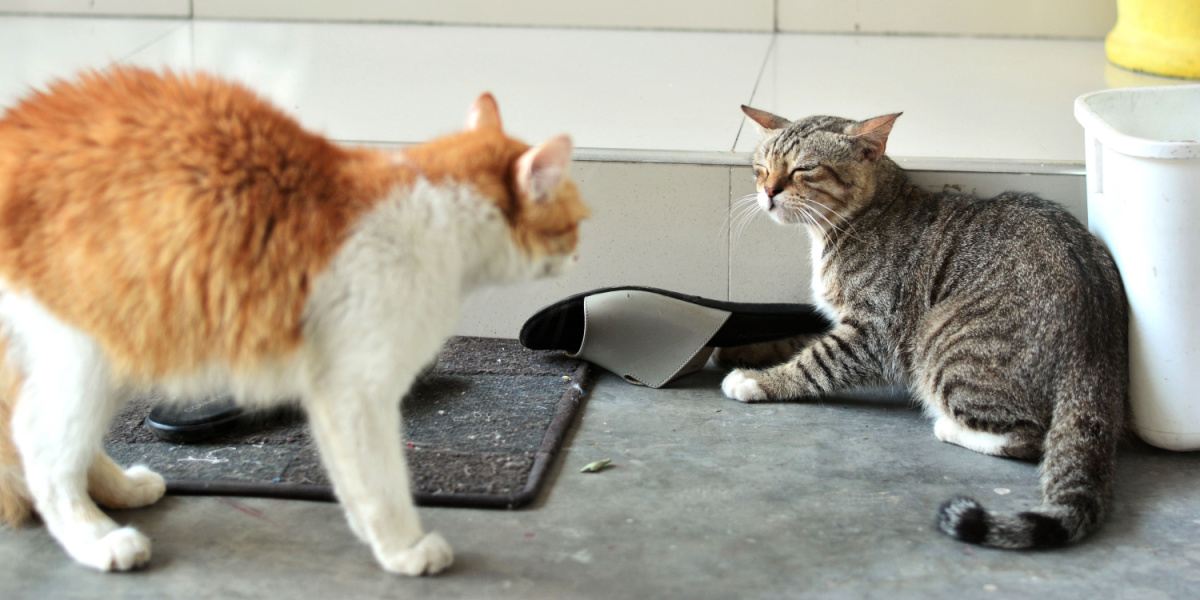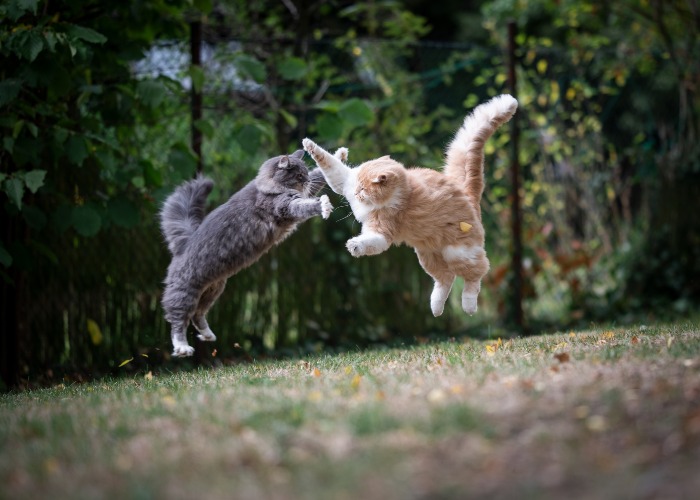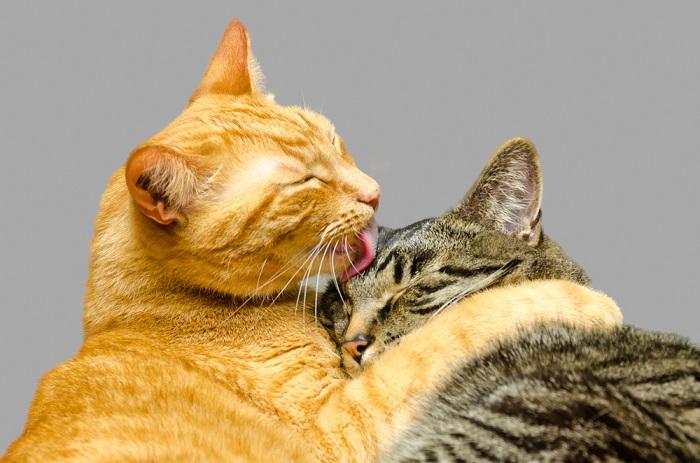
There is a common misconception amongst owners and professionals regarding dominance hierarchies in dogs and cats.
Our understanding of dominance theory and the behavior of domestic cats has grown considerably in the past decade. Unfortunately, the terms “alpha, top-cat, and boss-cat” are outdated and dangerous labels serving no purpose or offering solutions.
We must consider the natural social behavior of the domestic cat and avoid applying dominance concepts to feline behavior to treat conflict in multi-cat homes or resolve undesirable behaviors.
This article examines whether a dominance theory exists in pet cats and focuses on meeting your cat’s needs while balancing the relationship in multi-cat households.
The term "dominance" describes a relationship between individual animals established by force and aggression of one animal and submission by the other. Cats don’t have a hierarchical structure, and instead use a combination of personality types, motivations, health conditions, resource distribution, and learned experiences to determine how to behave in a given situation. To address dominant behavior in cats, be sure to provide ample numbers of each resource, including feeding bowls, beds, hiding places, litter boxes, and scratching posts. Key Takeaways
Definition of Dominance

Many pet owners do not understand the term “dominant” and how it applies to animals.
Dominance describes a relationship between individual animals established by force and aggression of one animal and submission by the other to determine who has priority access to multiple resources like food, resting spots, and mates (Bernstein 1981; Drews 1993).
Dominance or “being dominant” can’t be used to describe an animal’s personality or behavior since most behave differently depending on the environment and the animal they’re interacting with at that time.
Nevertheless, in one study, owners have recognized dominance as one of five key personality factors, which leads us to believe that owner’s perception needs to center on the relationship between individuals.
To better understand our pet cats, it’s helpful to consider the domestic cat’s complex social system.
Also Read: Why Do Cats Groom Each Other? Reasons Why Cats Socially Groom
Introduction to Power Structures in Feline Social Behavior

As a solitary species, cats don’t have a hierarchical structure.
Domestic cats have a common ancestry with the African wildcat. Despite selective breeding for the past 200 years, cats are genetically and behaviorally similar to their wild descendants; essentially, they are solitary species.
Studies of groups of feral cats from the past 20 years have revealed that the feline social system is flexible, allowing cats to live alone or in different-size groups depending on the density of cats and resource availability, mainly food. Feral colonies are usually matriarchal societies comprising related females and kittens with intact males at times attached to a group.
In a domestic home, things are a little more complex. Felines must adjust their behavior to live in the modern world with humans and cats from different social groups. They also have to share resources supplied by their owners with little control over their territory; hence, dominant relationships between cats started to appear.
How cats behave around food is a typical example of how a pet owner might view their cat as dominant. If a cat doesn’t approach the food bowl first or refrains from eating, we usually assume that this cat is submissive since the dominant cat always eats first. Another misunderstanding is when an owner observes a cat blocking access to the food bowl. This type of resource guarding isn’t a case of superiority; it’s likely this cat doesn’t recognize the other cat as a member of its group and is protecting its territorial resource.
The difference in relationships in multi-cat households reflects the cat’s territorial and opportunistic nature wanting all the resources for themselves. Confident or assertive cats learn which cats respond to intimidating behaviors and which don’t; therefore, they might dominate a timid cat but not others.
Since cats don’t have a hierarchical structure, it’s not a case of climbing up through the ranks to become the dominant feline member, but a combination of personality types, motivations, health conditions, resource distribution, and learned experiences that determine how a cat will behave in a given situation.
Also Read: The 8 Best Cat Bowls (Purchased And Tested)
Signs of Dominance in Cats

Dominance might be displayed thought passive aggression such as blocking a cat’s entry to an area.
A dominant cat monopolizes resources and uses active and passive aggression to control another cat’s access by keeping everything to themself. Dominance starts at an early age; however, it’s most evident during social maturity between 2 and 4 years of age when a cat begins to take possession of their territory and might show personality changes.
Feline behaviors identified as being dominant include:
- Vocalizations: Vocalizing offensively through hissing, growling, and snarling
- Physical aggression: Swatting, biting, chasing another cat throughout a territory
- Passive aggression: Staring, blocking entry to an area, standing or sitting on another individual, pushing a cat from a sleeping spot, and using aggressive body language
- Marking behaviors: Uurine marking and excessive grooming
Also Read: 9 Cat Behaviors Changes To Worry About
When Aggressive or Controlling Behavior Is a Problem

Lack of choice can cause frustration, increase tension, and trigger a confident cat to use aggressive actions to dominate another cat.
Competition for resources (food, water, resting place, toys, toileting facilities, even an owner’s attention) is the number one cause of conflict between indoor cats. When felines have no option other than to share essential resources, this can result in individuals attempting to dominate the territory and influence another cat’s access to such items.
Control is significant to cats as a species. Cats feel happiest with free access to do and go wherever they want. In multi-cat residences, power often gets removed with meals given at specific times and an indoor-only or supervised outdoor lifestyle unable to fulfill natural behaviors necessary for their survival.
Territory constraints and lack of choice can cause frustration, increase tension, and trigger a confident cat to use aggressive actions to dominate the behavior of another cat to increase its feelings of power within a territory.
Aggressive behaviors like swatting at a passing cat and blocking access to narrow thoroughfares (i.e., a cat flap or stairway), and preventing a less confident cat from reaching a litter tray are controlling behaviors that can result in a nervous cat peeing outside the litter box.
Let’s address what pet owners can do to resolve the feeling of cat superiority and equalize the relationship in multi-cat households.
Also Read: 5 Reasons You Should Get A Second Cat (And 3 You Shouldn’t)
Solutions for Dominant Behavior in Cats

To minimize competition, provide food in separate designated feeding areas.
There are several ways to address dominant behavior in cats. Most notably, avoid punishment since reprimanding innate behavior can lead to distress or frustration and damage the human-animal bond.
Don’t encourage or inadvertently reinforce assertive behavior. Only provide attention to an offending cat when it’s relaxed, not hissing, swatting at another cat or human, or displaying aggressive behaviors.
Reinforce desired behaviors with praise, toys, or a food treat. Positive reinforcement, like clicker training, also works well for pushy, food-motivated cats.
To avoid competition for cats fed nearby at set mealtimes, provide food in separate designated feeding areas within the home out of sight of each other. Moreover, to minimize control and give a perception of abundance, provide one feeding station per cat plus one extra with microchip-operated feeders.
Provide all resources like beds, and high resting places, along with hiding places in ample numbers (one per cat plus one extra in distinct locations). Place scratching posts near entrances, beds, and feeding stations to ensure a suitable surface for marking in areas of possible competition.
Supply adequate indoor litter facilities even when cats have access outdoors to reduce cats being cornered or guarded by self-assured cats.
For cats with outdoor access, supply two separate entry and exit points into the property via a cat flap, window, or door to avoid blocking by forceful individuals.
Lastly, provide daily opportunities for play and predatory behavior to help dissipate harassment or annoyance of other pets.
Also Read: Do Cats Get Jealous Of Other Cats?
Dominance in Cats: Final Thoughts

Cats are fascinating animals that keep us on our toes. Rest assured, cats aren’t hierarchical creatures and not plotting world domination.
Although we need to conduct further research on the ever-changing social relationships of domestic cats, with careful attention and control over resources provided to felines within modern living arrangements, they can live amicably without the need to dominate one another.
Also Read: Are My Cats Playing Or Fighting?
Frequently Asked Questions
How do you know which cat is alpha?
An "alpha cat" might be described as one that displays unwanted behavior, chases another feline or is aggressive toward other cats or humans, and doesn’t conform to their caregiver.
Since the notion of "alpha" is outdated and incorrect in the feline world, it’s helpful to establish your cat’s motivation for the behavior beyond the label so you can apply appropriate solutions.
How do you know which of your cats is dominant?
A dominant cat tries to take possession of all the resources and uses both active and passive aggression to intimidate or impede another feline’s entry, keeping preferential access to themselves.
Behaviors such as pursuing other cats all over the home, guarding the food bowl, climbing or sitting on another feline, blocking access to a room and demanding constant owner attention, food and play are typical.
How do I know my cats’ hierarchy?
Cats are not hierarchical animals; their social exchanges aren’t founded on any system of dominance or submission. Cats act as independent individuals that must establish proper social gesturing to facilitate living together. They use avoidance behavior and withdrawal responses to protect their survival.
Which cat is dominant in grooming?
A 1998 British study has noted that allogrooming (grooming one another, especially around the head and neck) is related to behavioral forms of confidence expression. They observed high-ranking animals grooming lower-ranking ones.
They also stated that the high-ranking groomer often adopted a higher posture by standing on all four or sitting on hind paws with outstretched forepaws while the allogromees were sitting or lying. The researchers have also hypothesized that allogrooming in domestic cats is an alternative way to redirect potential aggression rather than get into a fight that can harm cats as species.
-
Atkinson, T. (2018). Practical Feline Behaviour. Wallingford, Oxfordshire, UK: CABI. Retrieved November 25, 2022
-
Care, I. C. (2020, Septmeber 15). Advanced Feline Behaviour for Vet Professionals, Module 9 Clinical Animal Behaviour Part 2. (ISFM, Compiler) UK. Retrieved November 20, 2022
-
Consultants, I. A. (2019, 02 12). Position Statement on Dominance Theory. (IAABC, Compiler) USA. Retrieved November 29, 2022, from https://m.iaabc.org/about/position-statements/dominance/
-
Drews, C. (1993). The Concept and Definition of Dominance in Animal Behaviour. JSTOR, 125(3), 283-313. Retrieved November 19, 2022, from https://www.jstor.org/stable/4535117
-
Edinburgh, T. U. (2019). Understanding Feline Social Structure. (U. o. Edinburgh, Compiler) UK. Retrieved November 26, 2022
-
Halls, V. (2020). Dominance hierachy: myth or reality? (I. C. Care, Compiler) UK. Retrieved November 28, 2022
-
Heath, I. R. (2016). Feline Behavioral Health and Welfare. St Louis, MO: Elsevier. Retrieved November 30, 2022
-
Hoile, L. (2021, January). Dominance in cats: a relationship issue? (I. C. Care, Compiler) UK. Retrieved November 19, 2022
-
Sharon L. Crowell-Davis, T. M. (2004). Social organization in the cat: A modern understanding. Journal of Feline Medicine and Surgery, 6(1). Retrieved November 18, 2022, from https://journals.sagepub.com/doi/10.1016/j.jfms.2003.09.013
-
Trevorrow, N. (2015). Dominance 1 and 2. Behaviour matters. UK. Retrieved November 30, 2022
-
Bernstein PL. Behavior of Single Cats and Groups in the Home. Consultations in Feline Internal Medicine. 2006:675–85. doi: 10.1016/B0-72-160423-4/50074-3. Epub 2009 May 15. PMCID: PMC7149619.







